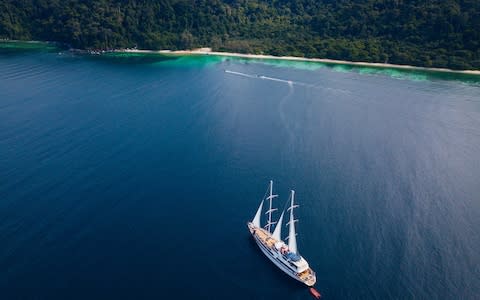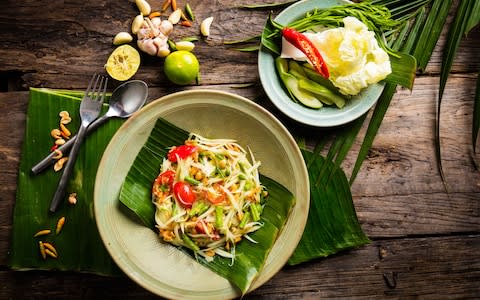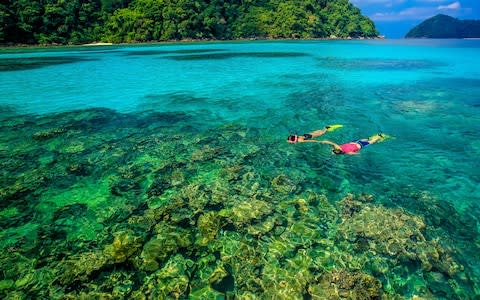A castaway experience in a corner of Thailand untouched by mass tourism

With its horseshoe of white sand set against a tangle of tropical foliage and water of such bright clarity that to describe it risks a cliché at every turn, Ao Mai Ngam beach is the stuff of travel brochures made flesh.
Sitting on a swing hanging from a Malabar tree, the only sound a background buzz of cicadas, I watched ghost crabs scuttling along the sand. Trunks twisted forwards toward the shallows, where a black tip reef shark darted out and clownfish shyly emerged from gently wafting anemones. Strolling along the beach, I passed a thicket of mangroves, their net of roots free from plastic. On the walk back, there were few enough footprints in the sand that I recognised my own.
These days, spots like this are hard to come by. Every tourist visits Thailand looking for a secluded beach, but when there are over 40 million of us a year, even a country with 2,000 miles of coast and more than 1,000 islands will struggle to contain the crowds. Beaches that look deserted in promotional pictures are often overrun. Maya Bay in Koh Phi Phi Leh, the once-untouched setting for the 2001 film The Beach, became so over-touristed that Thai authorities closed it indefinitely last year, to give the eco-system time to recover.
Even here in Mu Ko Surin National Park, an archipelago of five islands in the Andaman Sea, we didn’t have the beach to ourselves. But it was close enough. The handful of backpackers sharing the sand were prone on their towels, earphones in, dead to the world. I couldn’t blame them for dozing – they had spent the night in ramshackle tents pitched inland, just beyond the point where the sand becomes dirt.
By contrast, my home for the week was just visible on the horizon: a twin-masted, 164ft mega yacht called Panorama II. It has 25 compact but comfortable en-suite cabins, a wood-panelled lounge, a lounger-filled sun deck and a shady bar-restaurant. We were brought within wading distance of the shore by longtail boat. Despite my love for uncrowded places, I hadn’t the patience for tents, mosquito nets or dubious plumbing. But I was even less keen to join the hordes. I was looking for a fast-track off the beaten track, a sort of… castaway lite.

My small-ship cruise, with adventure specialists Intrepid Travel, gave me the answer. Sailing with a maximum of 49 passengers, there was no interminable waiting to disembark or board. The nine-day itinerary, for an adventure tour, was relaxed. Days often included just a snorkel and beach time; on a couple of occasions, there was a tour to local villages.
The other passengers were well-travelled Australians, Americans and Brits, for the most part empty-nested couples, but with a handful of friends, solos and younger folk in the mix. The atmosphere was sociable, with a sit-where-you-like dining policy. One day our guide Ay taught us to make Som Tum. The secret to the green papaya salad is the balance of sour lime, sweet palm sugar, umami fish sauce and fiery chilli. I think I’ve added enough with two crushed Bird’s Eyes, until I try the crew’s version, an eye-watering concoction made with ten.
Starting from bustling Phuket, we circled lesser-known islands and coastal spots in the Andaman Sea. The itinerary was designed to reduce contact with crowds – in the Surin Islands we enjoyed the beaches early, at their almost-deserted best, before boats bringing a few dozen day-trippers from the mainland arrived. Once they did, the longtail boats buzzed us around the headland to a prime snorkelling spot, where we came face to face with schools of barracuda, bright angelfish and elegant Moorish idols.

In the afternoon, we visit the Moken. It’s unusual to find human habitation in a national park, but these communities, sometimes called ‘sea gypsies’, have lived in the region for hundreds of years with their own culture, language and Animist belief system. From a village of basic wooden huts by the shore, the Moken fish, drive tourist boats and carve handicrafts to make a living. Formerly nomadic, it seems the government’s gifts of healthcare and education have come at the price of curtailed freedom, and I wonder whether our presence on their doorstep feels intrusive.
Another day our long-tail boat scudded across the calm water, racing the silver bullets of flying fish. The mainland appeared: a strip of land on the horizon. On Boxing Day 2004 this was the route taken by a towering wave, part of the tsunami which laid waste to stretches of coastline across south-east Asia, killing over 200,000 people. In the village of Ban Tale Nok, home to just 56 families, 47 died. Local guide Deh met us on the shore and showed us where the wave hit. Houses are now set further back, with the new primary school, paid for by fundraising, built high on the hill.
Intrepid gave half our tour fee to this fund, dedicated to developing the village and paying for schooling for children whose parents can’t afford it. The men in this Muslim society are mainly fishermen, but when the tsunami robbed families of fathers and incomes, the village women began their own businesses, making soap, shrimp paste and cigarettes wrapped in banana leaves. We sat down with Ma and Cha, who taught us how to make soap, scented with local ginger, turmeric, tamarind and mangosteen, and kanom jak – a snack of coconut and sticky rice flour. Chatting and joking via an interpreter, this felt like community tourism at its best.

In the Laem Son National Park, grazing the border with Myanmar, we messed about in the bay on Panorama’s sea kayaks, then sat under the pine trees with giant barbecued prawns, served up by our ever-smiling chef Roy.
At the end of the beach, a sign read: To The Viewpoint. Expecting a gentle walk, I attempted the expedition in a bikini and flip-flops. Scrambling through undergrowth and hauling myself on a rope up near-vertical sections of “path”, I reached the top grazed and covered in apricot-hued dust. The views over double-pronged Buffalo Horns Bay were a fitting reward, but I’d have paid good money for an easier trek down.
Oh dear – perhaps this soft route to seclusion had left me too pampered to truly venture off the beaten track any more.
How to do it
From £1,767 for the nine-day Cruising the Thai Islands from Phuket itinerary on Panorama II including most meals and activities. Departures run in December and January (0808 274 5111; intrepidtravel.com).

